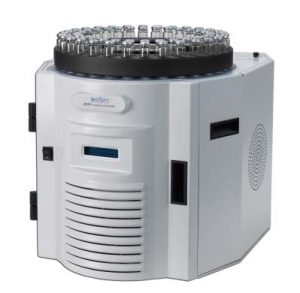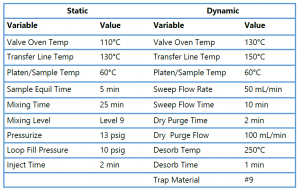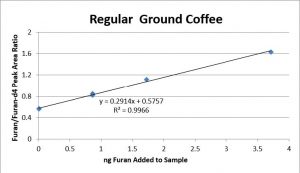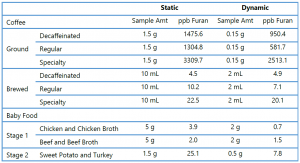Evaluating Food Products for Furan and Other Volatile Organic Compounds
Introduction
Furan is an aromatic heterocyclic compound of four carbon atoms and one oxygen atom. It has been found not only in heat processed foods, but also one of numerous compounds, including dioxins, produced during incineration of waste. Because of its association with dioxins, the National Toxicology Program has been evaluating furan for potential carcinogenetic properties and found it to have cytotoxic and carcinogenetic effects in laboratory animals. This study presents the data for performing the current FDA static headspace standard addition method for the detection of furan in food along with a dynamic headspace method. Other volatile organic compounds can also be determined simultaneously with the furan assay. A HT3 Headspace Analyzer was used in the both the static and the dynamic mode along with a GC/MS for the quantitation of furan in food. An environmental column was used for the quantitation of furan, and to assist in the detection and preliminary identification of additional volatile organic compounds (VOCs) released from the samples. These VOCs, including benzene and toluene can be quickly identified with the environmental column and confirmed when an USEPA Method standard is included in the analysis.

Figure 1. SCION Instruments HT3 Headspace Sampler

Table 1. HT3 Headspace Sampler Parameters

Table 2. GC/MS Method parameters
For this study three types of ground coffee, a decaffeinated blend, a regular blend and a specialty house blend were obtained. The ground coffees were tested for furan by weighing the ground coffee beans into 22mL headspace vials and adding water. 2mL of the brewed coffee was placed into headspace vials for the dynamic headspace method. Along with the coffee samples, chicken and beef Stage 1 baby food meats, and a Stage 2 baby food mix of sweet potatoes and turkey were obtained. These were weighed into 22mL headspace vials and the appropriate amount of water or saturated sodium chloride solution added. Separate stock standard solutions of furan and furan-d4, the internal standard (IS), were prepared by pipetting 50µL of the standards into separate 22mL headspace vials containing 20.0mL of purge and trap methanol and weighing the amount of standard added. The stock standard solutions were further diluted in water to produce working standards close to the expected furan concentrations in the food samples. A furan/furan-d4 calibration curve from 1 to 250 times the expected food furan concentration was prepared to determine the approximate concentration for the standard addition method. The furan mass 68 m/z/furan-d4 mass 72 m/z ratio was plotted versus the furan concentration in ng. The food samples were then analyzed singularly to estimate the ng furan in the food. This estimated ng concentration was then defined as x. Seven preparations of each food sample were prepared by weighing or measuring equivalent sample amounts into seven vials. These vials were spiked with both the furan working standard and the furan–d4 IS working standard as follows. The furan-d4 working IS was added to all seven vials at approximately 2x. The furan working standard was added to only 4 of the vials. Three vials were not spiked and are 0x. Two vials were spiked at 0.5x, one vial was spiked at 1x and the remaining vial was spiked at 2x. The vials were sealed and analyzed with the static headspace method parameters. One set of food was analyzed with the static headspace method following the FDA method. A second set of food was analyzed with the dynamic method to compare the furan results to the static method.
Results
The peak area of the furan mass 68 m/z and the furan-d4 mass 72 m/z for vials were calculated with the Mass Spec software. The ratio of the furan mass 68 m/z peak area to the furan-d4 mass 72 m/z peak area for each of the 7 vials per sample was calculated. This ratio was then plotted versus the concentration of furan added to each of the 7 vials per sample. The linear regression of the 7 data points for each sample was calculated. The ng furan for the sample was calculated by solving the linear regression equation for y=0, the y intercept. Figure 2 is a typical plot with the linear equation for the standard addition plot. The ppb furan was calculated by dividing the ng furan found in the food sample by the weight or volume of sample used for analysis. The ppb furan for each food type is presented in Table 3 for both the static and the dynamic concentration.

Figure 2: Standard Addition Curve Data for Regular Ground Coffee of the Furan/Furan-d4 Peak Area Ratio versus the Concentration in ng

Table 3. Calculated ppb Furan Concentrations for the Various Food Products Evaluated
Conclusion
Various foods were tested with the current FDA static headspace for furan utilizing the HT3. The dynamic headspace option of the HT3, where the volatile compounds are trapped and concentrated to be rapidly desorbed to the GC/MS was also used for the quantitation of furan in food. The HT3 loop filled headspace instrument in the static mode with the environmental column and the GC/MS system performed exceptionally well for the detection and quantification of furan following the FDA standard addition method. The environmental column provided excellent separation and detection of not only the furan but other volatile food and beverage compounds of concern. The various foods were also analyzed with the dynamic option of the HT3 Headspace Sampler. The target compound, furan was well trapped with the #9 trap for quantitative desorption to the GC/MS. The dynamic headspace procedure allowed smaller quantities of food products to be used for the analysis. The dynamic method provided similar results to the current static headspace FDA standard addition method.
Download Application Note
Download the complete Application Note: Evaluating Food Products for Furan and Other Volatile Organic Compounds
Keep in Touch
If you wish to speak to a member of our team about more information, please don’t hesitate to contact us. Or if you wish to keep up to date with SCION Instruments latest research and articles, why not join us on social media and sign up to our newsletters today?
